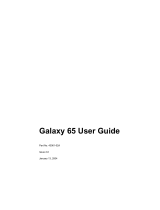
DELL PowerVault MD3200i/MD3220i Technical Guide Book
3
Product Overview
The MD3200i series of storage arrays were designed with performance in mind. Each controller is
equipped with four 1Gb Ethernet ports providing total aggregated bandwidth of 800MB/s of throughput
for a dual controller system which is double the throughput of the MD3000i and most competitive
products in the entry-level iSCSI SAN array market. For small block random access applications like
databases, the MD3200i series is capable of performing over 2X the IOP performance of the MD3000i
making it a great platform for a wide variety of applications and IT environments.
When it comes to flexibility, the MD3200i series of storage arrays is second to none. There are four
base offerings to choose from allowing users to best meet their specific IT demands and budgets.
• MD3200i single controller model – A single RAID controller in a 2U, 12 drive 3.5” HDD enclosure
provides the lowest cost with the highest storage capacity offering when using large near-line
SAS drives.
• MD3200i dual controller model – Dual, active/active controllers in a 2U, 12 drive 3.5” HDD
enclosure provides a high availability and high capacity storage offering when using large near-
line SAS drives.
• MD3220i single controller model – A single RAID controller in a 2U, 24 drive 2.5” HDD enclosure
provides a low cost, high spindle count storage solution that maximizes IOPS when using SSD or
15K, 2.5” SAS drives.
• MD3220i dual controller model – Dual, active/active controllers in a 2U, 24 drive 2.5” HDD
enclosure provides the combination of a highly available storage solution with a high spindle
count to maximize IOPS when using SSD or 15K, 2.5” SAS drives.
This series of arrays raises the bar for scalability in the entry-level storage space. Each model is
capable of support up to 32 physical servers when connected to one or more 1Gb Ethernet switches.
Additional storage capacity can be added up to a maximum of 96 HDD via the MD1200 and/or MD1220
enclosures. Users can also mix 3.5” and 2.5” enclosures behind their base units in order to achieve the
optimal drive tiering that best matches their application needs. Within each enclosure users can mix
SSD, SAS and near-line SAS drives maximizing their return on investment.
In addition to the above mentioned features, the MD3200i series offers optional data protection
features like snap shots and virtual disk copy services to assist users in protecting their data in a more
effective manner. Initial set up is also much easier than the previous product with the addition of
wizard enabled tools and improvements in the Modular Disk Storage Manager.
iSCSI
iSCSI (Internet Small Computer System Interface) is an industry standard that allows SCSI block I/O
protocol to be sent over the network using a TCP/IP-based protocol for establishing and managing
connections between IP-based storage devices, hosts and clients. iSCSI SAN solutions (often called IP
SANs) consist of iSCSI initiators (software driver or adapter) in the application servers, connected to
iSCSI arrays by means of standard Gigabit Ethernet switches, routers and cables.
IP SANs are enabling organizations around the globe to maximize their existing IT investments while
deploying effective and efficient networked data management solutions. iSCSI is particularly
interesting as a SAN alternative to direct-attached storage in environments where simplicity,
flexibility, price/performance and availability of administrative staff are critical IT decision factors.





















